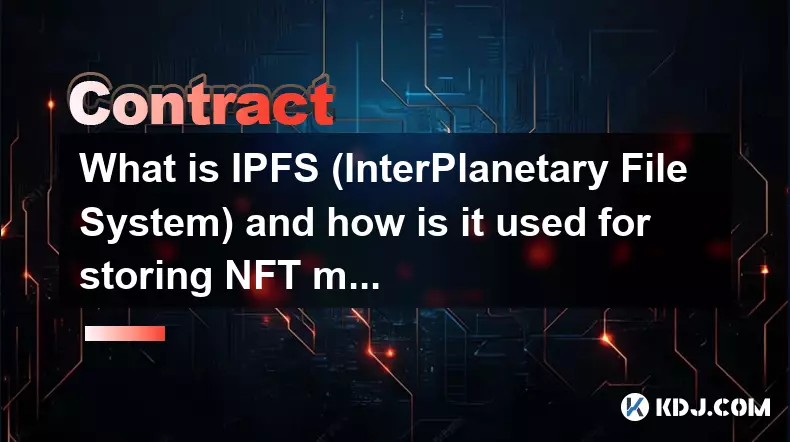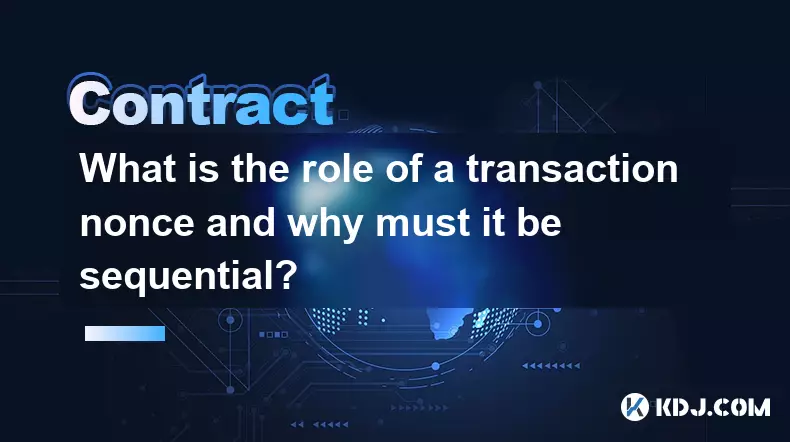-
 bitcoin
bitcoin $102877.190955 USD
1.88% -
 ethereum
ethereum $3430.435064 USD
4.52% -
 tether
tether $0.999264 USD
-0.05% -
 xrp
xrp $2.307310 USD
4.49% -
 bnb
bnb $987.740692 USD
3.82% -
 solana
solana $161.947760 USD
3.97% -
 usd-coin
usd-coin $0.999712 USD
-0.05% -
 tron
tron $0.292810 USD
2.93% -
 dogecoin
dogecoin $0.179738 USD
10.70% -
 cardano
cardano $0.580716 USD
8.75% -
 hyperliquid
hyperliquid $42.463448 USD
8.40% -
 chainlink
chainlink $15.763437 USD
7.05% -
 zcash
zcash $649.595636 USD
17.21% -
 bitcoin-cash
bitcoin-cash $511.610261 USD
7.19% -
 stellar
stellar $0.292537 USD
7.91%
What is IPFS (InterPlanetary File System) and how is it used for storing NFT metadata?
IPFS ensures NFT metadata is decentralized, immutable, and censorship-resistant by storing it across a global peer-to-peer network instead of centralized servers.
Nov 08, 2025 at 06:00 pm

Understanding IPFS and Its Role in Decentralized Storage
1. The InterPlanetary File System (IPFS) is a peer-to-peer hypermedia protocol designed to make the web faster, safer, and more open. It operates as a distributed file system that allows files to be stored and retrieved based on their content rather than location. Each file uploaded to IPFS receives a unique cryptographic hash, which acts as its permanent address. This eliminates reliance on centralized servers and reduces vulnerability to censorship or downtime.
2. Unlike traditional HTTP-based systems where data is accessed through server locations, IPFS uses content addressing. When a user requests a file, the network locates the nearest node hosting that content and delivers it efficiently. This model significantly improves load times and redundancy across the network. Because multiple nodes can host the same content, availability remains high even if individual nodes go offline.
3. Files on IPFS are immutable, meaning once a file is added with a specific hash, any change to the content generates a new hash. This feature ensures authenticity and integrity, making it ideal for applications requiring tamper-proof records. In blockchain ecosystems, this immutability aligns perfectly with the principles of transparency and trustlessness.
4. To participate in IPFS, users run nodes that store and share files. These nodes form a global network where data is replicated across various geographic regions. Public gateways also exist to allow standard browsers to access IPFS-hosted content without installing special software. While public gateways offer convenience, running private nodes enhances security and control over data persistence.
Why NFT Metadata Needs Decentralized Solutions
1. Non-fungible tokens (NFTs) represent ownership of digital assets such as artwork, music, or virtual real estate. However, most blockchains only store minimal information about an NFT—typically just ownership details and a pointer to external metadata. This metadata often includes attributes like name, description, image URL, and properties that define the token’s characteristics.
2. Storing metadata on centralized servers poses significant risks. If the hosting service shuts down or removes content, the link breaks, leading to 'link rot.' As a result, the NFT may lose its visual representation or descriptive details, undermining its value and utility. Centralization contradicts the decentralized ethos of blockchain technology.
3. IPFS mitigates these risks by providing a censorship-resistant and durable way to host NFT metadata. Instead of relying on fragile URLs tied to corporate infrastructure, creators upload metadata to IPFS and embed the resulting content hash into the smart contract. This ensures that as long as at least one node hosts the file, it remains accessible indefinitely.
4. Many NFT marketplaces and minting platforms now integrate IPFS natively. When artists mint NFTs, the platform automatically packages the metadata and associated media into JSON format and uploads them to IPFS. The returned CID (Content Identifier) becomes part of the token’s on-chain record, creating a permanent, verifiable reference.
How IPFS Integrates with Blockchain-Based NFTs
1. During NFT creation, developers generate a JSON file containing all relevant metadata, including links to images, animations, or 3D models—all of which are also hosted on IPFS. Once this JSON is uploaded, it receives a unique CID. This CID is then embedded into the NFT’s smart contract, typically within the tokenURI function, which external applications query to display the asset.
2. When a wallet or marketplace loads an NFT, it reads the tokenURI from the blockchain, resolves the IPFS CID using a gateway (like dweb.link or ipfs.io), and retrieves the metadata. The process happens seamlessly in the background, allowing users to view rich content without knowing the underlying mechanics.
3. By anchoring metadata on IPFS and referencing it via immutable hashes, NFTs achieve true decentralization and permanence. Even if the original creator disappears or stops supporting the project, the data persists as long as nodes continue to pin it. This resilience strengthens confidence in digital ownership and supports long-term collectibility.
4. Some advanced implementations use Filecoin in conjunction with IPFS for guaranteed storage. Filecoin provides economic incentives for nodes to store specific data over time, adding another layer of reliability. Projects requiring archival-grade durability can leverage decentralized storage markets to ensure their NFTs remain intact for decades.
Frequently Asked Questions
What happens if no one hosts my NFT's metadata on IPFS?If all nodes that pinned a particular piece of metadata stop hosting it, the content becomes temporarily inaccessible until someone repins it. Permanent availability requires active pinning services or integration with incentivized storage networks like Filecoin.
Can IPFS-hosted metadata be updated?Direct updates aren’t possible due to content immutability. To modify metadata, a new version must be uploaded to IPFS, generating a new CID. Updating the tokenURI on-chain would then point to the revised metadata, though this approach varies depending on contract design.
Is IPFS completely free to use for NFT projects?Uploading small files to public IPFS gateways is generally free, but relying solely on them carries availability risks. For production-level applications, teams often use dedicated pinning services such as Pinata, Infura, or nft.storage, some of which offer free tiers with limitations.
How do I verify that my NFT’s metadata is truly on IPFS?You can inspect the token’s smart contract and extract the tokenURI. If it starts with “ipfs://” followed by a CID, the metadata is stored on IPFS. You can then resolve it using a public gateway like https://ipfs.io/ipfs/[CID] to view the raw JSON and confirm its contents.
Disclaimer:info@kdj.com
The information provided is not trading advice. kdj.com does not assume any responsibility for any investments made based on the information provided in this article. Cryptocurrencies are highly volatile and it is highly recommended that you invest with caution after thorough research!
If you believe that the content used on this website infringes your copyright, please contact us immediately (info@kdj.com) and we will delete it promptly.
- Ripple (XRP) in 2026: Hold or Fold? A Look at XRP's Future and Emerging DeFi Alternatives
- 2025-11-08 18:35:01
- Zcash ZEC Coin Price Explosion: From Privacy Niche to Center Stage
- 2025-11-08 18:55:01
- Berachain Price Prediction: Navigating the Honeycomb Hype in Crypto
- 2025-11-08 18:55:01
- Arthur Hayes, Gold, and Bitcoin: A Modern Monetary Trinity?
- 2025-11-08 19:15:01
- Shiba Inu's Next Move: Navigating a Shifting Market
- 2025-11-08 19:20:01
- Pakistan's Crypto Crossroads: Balancing Opportunity with Asset-Backed Realities
- 2025-11-08 19:20:01
Related knowledge

What is a state machine and how can a contract be designed as one?
Nov 08,2025 at 02:19pm
Understanding State Machines in Blockchain Context1. A state machine is a computational model used to design systems that transition between defined s...

How do you upgrade a smart contract using the UUPS proxy pattern?
Nov 09,2025 at 01:19am
Understanding the UUPS Proxy Pattern in Smart Contract DevelopmentThe UUPS (Universal Upgradeable Proxy Standard) pattern has become a cornerstone in ...

How do you handle fixed-point math and decimals in Solidity?
Nov 08,2025 at 11:40pm
Understanding Fixed-Point Arithmetic in Solidity1. Solidity does not natively support floating-point numbers, which means developers must rely on fixe...

What is the role of a transaction nonce and why must it be sequential?
Nov 09,2025 at 01:00am
Understanding the Transaction Nonce in Blockchain Systems1. A transaction nonce is a number used once, associated with a user's account in blockchain ...

What is a front-running attack and how can it be mitigated in smart contracts?
Nov 08,2025 at 11:20am
Understanding Front-Running in Blockchain Transactions1. In the context of blockchain and decentralized applications, a front-running attack occurs wh...

What is IPFS (InterPlanetary File System) and how is it used for storing NFT metadata?
Nov 08,2025 at 06:00pm
Understanding IPFS and Its Role in Decentralized Storage1. The InterPlanetary File System (IPFS) is a peer-to-peer hypermedia protocol designed to mak...

What is a state machine and how can a contract be designed as one?
Nov 08,2025 at 02:19pm
Understanding State Machines in Blockchain Context1. A state machine is a computational model used to design systems that transition between defined s...

How do you upgrade a smart contract using the UUPS proxy pattern?
Nov 09,2025 at 01:19am
Understanding the UUPS Proxy Pattern in Smart Contract DevelopmentThe UUPS (Universal Upgradeable Proxy Standard) pattern has become a cornerstone in ...

How do you handle fixed-point math and decimals in Solidity?
Nov 08,2025 at 11:40pm
Understanding Fixed-Point Arithmetic in Solidity1. Solidity does not natively support floating-point numbers, which means developers must rely on fixe...

What is the role of a transaction nonce and why must it be sequential?
Nov 09,2025 at 01:00am
Understanding the Transaction Nonce in Blockchain Systems1. A transaction nonce is a number used once, associated with a user's account in blockchain ...

What is a front-running attack and how can it be mitigated in smart contracts?
Nov 08,2025 at 11:20am
Understanding Front-Running in Blockchain Transactions1. In the context of blockchain and decentralized applications, a front-running attack occurs wh...

What is IPFS (InterPlanetary File System) and how is it used for storing NFT metadata?
Nov 08,2025 at 06:00pm
Understanding IPFS and Its Role in Decentralized Storage1. The InterPlanetary File System (IPFS) is a peer-to-peer hypermedia protocol designed to mak...
See all articles





















![The Graph Price Prediction [GRT Crypto Price News Today] The Graph Price Prediction [GRT Crypto Price News Today]](/uploads/2025/11/07/cryptocurrencies-news/videos/690d4df44fe69_image_500_375.webp)



















































